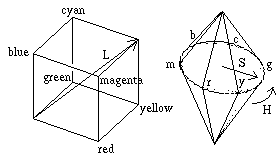RGB TO HSL
N.B. This page is copied from
http://blas.cis.mcmaster.ca/~monger/hsl-rgb.html
The conversion algorithms for these color spaces are originally from the book
Fundamentals of Interactive Computer Graphics by Foley
and van Dam (c 1982, Addison-Wesley). Chapter 17 describes color spaces and
shows their relationships via easy-to-follow
diagrams.
RGB - HSL
- Convert the RBG values to the range 0-1
- Find min and max values of R, B, G, say Xmin and Xmax
- Let L = (Xmax + Xmin) / 2
- If Xmax and Xmin are equal, S is defined to be 0,
and H is undefined but in programs usually written as 0
- Otherwise, test L:
- If L < 1/2, S=(Xmax - Xmin)/(Xmax + Xmin)
- Else, S=(Xmax - Xmin)/(2 - Xmax - Xmin)
- Now find H:
- If R=Xmax, H = (G-B)/(Xmax - Xmin)
- If G=Xmax, H = 2 + (B-R)/(Xmax - Xmin)
- If B=Xmax, H = 4 + (R-G)/(Xmax - Xmin)
If H < 0 set H = H + 6.
Notice that H ranges from 0 to 6.
RGB space is a cube, and HSL space is a double hexacone, where L is
the principal diagonal of the RGB cube. Thus corners of the RGB cube;
red, yellow, green, cyan, blue, and magenta, become the vertices of
the HSL hexagon. Then the value 0-6 for H tells you which section
of the hexgon you are in. H is most commonly given as in degrees,
so to convert H = H*60.0
(If H is negative, add 360 to complete the conversion.)

HSL - RGB
- If S=0, define R, G, and B all to L
- Otherwise, test L:
- If L < 1/2, temp2=L*(1+S)
- Else, temp2=L+S - L*S
- Let temp1 = 2 * L - temp2
- Convert H to the range 0-1
- For each of R, G, B, compute another temporary value, temp3, as follows:
- for R, temp3=H+1/3; if temp3 > 1, temp3 = temp3 - 1
- for G, temp3=H
- for B, temp3=H-1/3; if temp3 < 0, temp3 = temp3 + 1
- For each of R, G, B, do the following test:
- If temp3 < 1/6, color=temp1+(temp2-temp1)*6*temp3
- Else if temp3 < 1/2, color=temp2
- Else if temp3 < 2/3, color=temp1+(temp2-temp1)*(2/3 - temp3)*6
- Else color=temp1
- Scale back to the range 0-255
Marco Corvi - Page hosted by
geocities.com.

